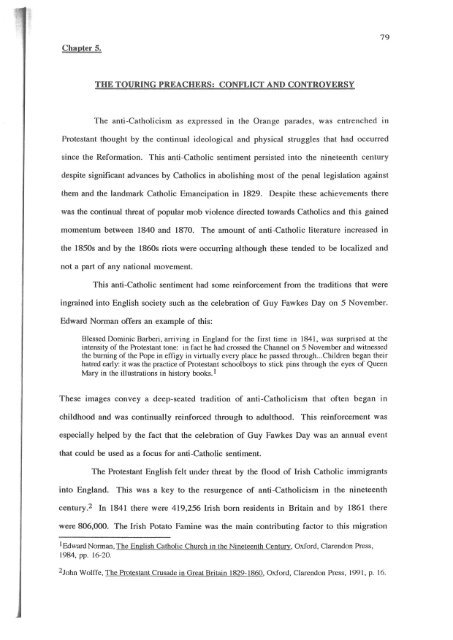TRANSPLANTED IRISH INSTITUTIONS - University of Canterbury
TRANSPLANTED IRISH INSTITUTIONS - University of Canterbury
TRANSPLANTED IRISH INSTITUTIONS - University of Canterbury
Create successful ePaper yourself
Turn your PDF publications into a flip-book with our unique Google optimized e-Paper software.
Chapter 5.<br />
79<br />
THE TOURING PREACHERS: CONFLICf AND CONTROVERSY<br />
The anti-Catholicism as expressed in the Orange parades, was entrenched in<br />
Protestant thought by the continual ideological and physical struggles that had occurred<br />
since the Reformation. This anti-Catholic sentiment persisted into the nineteenth century<br />
despite significant advances by Catholics in abolishing most <strong>of</strong> the penal legislation against<br />
them and the landmark Catholic Emancipation in 1829. Despite these achievements there<br />
was the continual threat <strong>of</strong> popular mob violence directed towards Catholics and this gained<br />
momentum between 1840 and 1870. The amount <strong>of</strong> anti-Catholic literature increased in<br />
the 1850s and by the 18608 riots were occurring although these tended to be localized and<br />
not a part <strong>of</strong> any national movement.<br />
This anti-Catholic sentiment had some reinforcement from the traditions that were<br />
ingrained into English society such as the celebration <strong>of</strong> Guy Fawkes Day on 5 November.<br />
Edward Norman <strong>of</strong>fers an example <strong>of</strong> this:<br />
Blessed Dominic Barberi, arriving in England for the first time in 1841, was surprised at the<br />
intensity <strong>of</strong> the Protestant tone: in fact he had crossed the Channel on 5 November and witnessed<br />
the burning <strong>of</strong> the Pope in effigy in virtually every place he passed through ... Children began their<br />
hatred early: it was the practice <strong>of</strong> Protestant schoolboys to stick pins through the eyes <strong>of</strong> Queen<br />
Mary in the illustrations in history books. I<br />
These images convey a deep-seated tradition <strong>of</strong> anti-Catholicism that <strong>of</strong>ten began in<br />
childhood and was continually reinforced through to adulthood. This reinforcement was<br />
especially helped by the fact that the celebration <strong>of</strong> Guy Fawkes Day was an annual event<br />
that could be used as a focus for anti-Catholic sentiment.<br />
The Protestant English felt under threat by the flood <strong>of</strong> Irish Catholic immigrants<br />
into England. This was a key to the resurgence <strong>of</strong> anti-Catholicism in the nineteenth<br />
century.2 In 1841 there were 419,256 Irish born residents in Britain and by 1861 there<br />
were 806,000. The Irish Potato Famine was the main contributing factor to this migration<br />
I Edward Nonnan, The English Catholic Church in the Nineteenth Century, Oxford, Clarendon Press,<br />
1984, pp. 16-20.<br />
2John Wolffe. The Protestant Crusade in Great Britain 1829-1860. Oxford. Clarendon Press. 1991. p. 16.
















